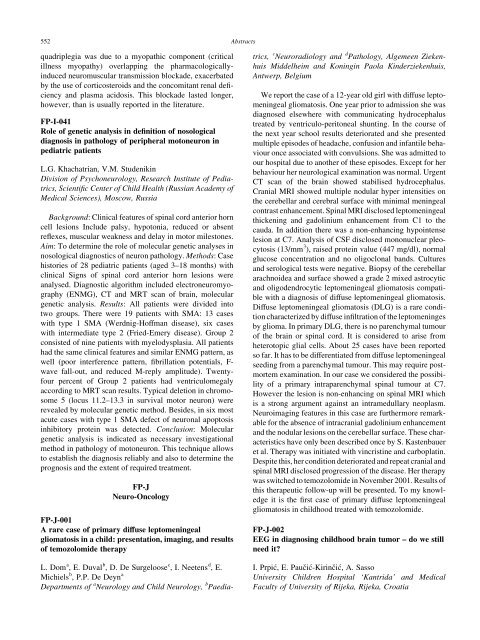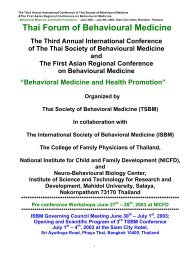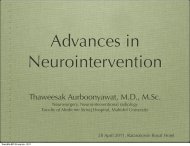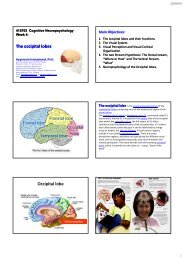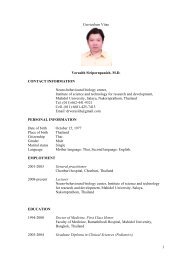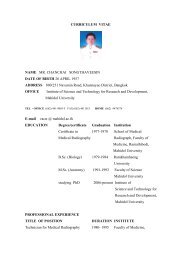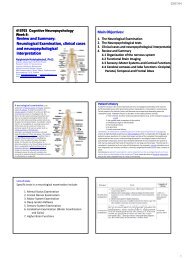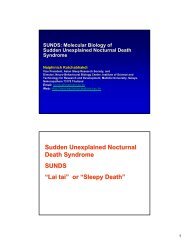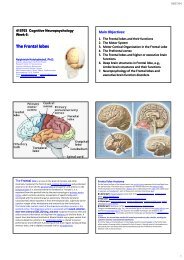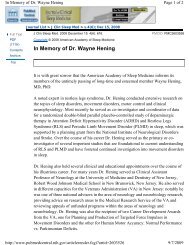PDF File - Mahidol University
PDF File - Mahidol University
PDF File - Mahidol University
Create successful ePaper yourself
Turn your PDF publications into a flip-book with our unique Google optimized e-Paper software.
552<br />
Abstracts<br />
quadriplegia was due to a myopathic component (critical<br />
illness myopathy) overlapping the pharmacologicallyinduced<br />
neuromuscular transmission blockade, exacerbated<br />
by the use of corticosteroids and the concomitant renal deficiency<br />
and plasma acidosis. This blockade lasted longer,<br />
however, than is usually reported in the literature.<br />
FP-I-041<br />
Role of genetic analysis in definition of nosological<br />
diagnosis in pathology of peripheral motoneuron in<br />
pediatric patients<br />
L.G. Khachatrian, V.M. Studenikin<br />
Division of Psychoneurology, Research Institute of Pediatrics,<br />
Scientific Center of Child Health (Russian Academy of<br />
Medical Sciences), Moscow, Russia<br />
Background: Clinical features of spinal cord anterior horn<br />
cell lesions Include palsy, hypotonia, reduced or absent<br />
reflexes, muscular weakness and delay in motor milestones.<br />
Aim: To determine the role of molecular genetic analyses in<br />
nosological diagnostics of neuron pathology. Methods: Case<br />
histories of 28 pediatric patients (aged 3–18 months) with<br />
clinical Signs of spinal cord anterior horn lesions were<br />
analysed. Diagnostic algorithm included electroneuromyography<br />
(ENMG), CT and MRT scan of brain, molecular<br />
genetic analysis. Results: All patients were divided into<br />
two groups. There were 19 patients with SMA: 13 cases<br />
with type 1 SMA (Werdnig-Hoffman disease), six cases<br />
with intermediate type 2 (Fried-Emery disease). Group 2<br />
consisted of nine patients with myelodysplasia. All patients<br />
had the same clinical features and similar ENMG pattern, as<br />
well (poor interference pattern, fibrillation potentials, F-<br />
wave fall-out, and reduced M-reply amplitude). Twentyfour<br />
percent of Group 2 patients had ventriculomegaly<br />
according to MRT scan results. Typical deletion in chromosome<br />
5 (locus 11.2–13.3 in survival motor neuron) were<br />
revealed by molecular genetic method. Besides, in six most<br />
acute cases with type 1 SMA defect of neuronal apoptosis<br />
inhibitory protein was detected. Conclusion: Molecular<br />
genetic analysis is indicated as necessary investigational<br />
method in pathology of motoneuron. This technique allows<br />
to establish the diagnosis reliably and also to determine the<br />
prognosis and the extent of required treatment.<br />
FP-J<br />
Neuro-Oncology<br />
FP-J-001<br />
A rare case of primary diffuse leptomeningeal<br />
gliomatosis in a child: presentation, imaging, and results<br />
of temozolomide therapy<br />
L. Dom a , E. Duval b , D. De Surgeloose c , I. Neetens d ,E.<br />
Michiels b , P.P. De Deyn a<br />
Departments of a Neurology and Child Neurology, b Paediatrics,<br />
c Neuroradiology and d Pathology, Algemeen Ziekenhuis<br />
Middelheim and Koningin Paola Kinderziekenhuis,<br />
Antwerp, Belgium<br />
We report the case of a 12-year old girl with diffuse leptomeningeal<br />
gliomatosis. One year prior to admission she was<br />
diagnosed elsewhere with communicating hydrocephalus<br />
treated by ventriculo-peritoneal shunting. In the course of<br />
the next year school results deteriorated and she presented<br />
multiple episodes of headache, confusion and infantile behaviour<br />
once associated with convulsions. She was admitted to<br />
our hospital due to another of these episodes. Except for her<br />
behaviour her neurological examination was normal. Urgent<br />
CT scan of the brain showed stabilised hydrocephalus.<br />
Cranial MRI showed multiple nodular hyper intensities on<br />
the cerebellar and cerebral surface with minimal meningeal<br />
contrast enhancement. Spinal MRI disclosed leptomeningeal<br />
thickening and gadolinium enhancement from C1 to the<br />
cauda. In addition there was a non-enhancing hypointense<br />
lesion at C7. Analysis of CSF disclosed mononuclear pleocytosis<br />
(13/mm 3 ), raised protein value (447 mg/dl), normal<br />
glucose concentration and no oligoclonal bands. Cultures<br />
and serological tests were negative. Biopsy of the cerebellar<br />
arachnoidea and surface showed a grade 2 mixed astrocytic<br />
and oligodendrocytic leptomeningeal gliomatosis compatible<br />
with a diagnosis of diffuse leptomeningeal gliomatosis.<br />
Diffuse leptomeningeal gliomatosis (DLG) is a rare condition<br />
characterized by diffuse infiltration of the leptomeninges<br />
by glioma. In primary DLG, there is no parenchymal tumour<br />
of the brain or spinal cord. It is considered to arise from<br />
heterotopic glial cells. About 25 cases have been reported<br />
so far. It has to be differentiated from diffuse leptomeningeal<br />
seeding from a parenchymal tumour. This may require postmortem<br />
examination. In our case we considered the possibility<br />
of a primary intraparenchymal spinal tumour at C7.<br />
However the lesion is non-enhancing on spinal MRI which<br />
is a strong argument against an intramedullary neoplasm.<br />
Neuroimaging features in this case are furthermore remarkable<br />
for the absence of intracranial gadolinium enhancement<br />
and the nodular lesions on the cerebellar surface. These characteristics<br />
have only been described once by S. Kastenbauer<br />
et al. Therapy was initiated with vincristine and carboplatin.<br />
Despite this, her condition deteriorated and repeat cranial and<br />
spinal MRI disclosed progression of the disease. Her therapy<br />
was switched to temozolomide in November 2001. Results of<br />
this therapeutic follow-up will be presented. To my knowledge<br />
it is the first case of primary diffuse leptomeningeal<br />
gliomatosis in childhood treated with temozolomide.<br />
FP-J-002<br />
EEG in diagnosing childhood brain tumor – do we still<br />
need it?<br />
I. Prpić, E. Paučić-Kirinčić, A. Sasso<br />
<strong>University</strong> Children Hospital ‘Kantrida’ and Medical<br />
Faculty of <strong>University</strong> of Rijeka, Rijeka, Croatia


